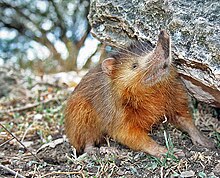| Solenodons Temporal range:
| |
|---|---|

| |
| Hispaniolan solenodon | |
| Scientific classification | |
| Domain: | Eukaryota |
| Kingdom: | Animalia |
| Phylum: | Chordata |
| Class: | Mammalia |
| Order: | Eulipotyphla |
| Family: | Solenodontidae Gill, 1872 |
| Type genus | |
| Solenodon Brandt, 1833
| |
| Genera | |

| |
Solenodons /soʊˈlɛnədɒnz/ (from Greek: σωλήν sōlḗn, 'channel' or 'pipe' and Greek: ὀδούς odoús, 'tooth')[3] are venomous, nocturnal, burrowing, insectivorous mammals belonging to the family Solenodontidae /soʊˌlɛnəˈdɒntɪdiː/. The two living solenodon species are the Cuban solenodon (Atopogale cubana) and the Hispaniolan solenodon (Solenodon paradoxus). Threats to both species include habitat destruction and predation by non-native cats, dogs, and mongooses, introduced by humans to the solenodons' home islands to control snakes and rodents.[4][5][6]
The Hispaniolan solenodon covers a wide range of habitats on the island of Hispaniola from lowland dry forest to highland pine forest. Two other described species became extinct during the Quaternary period.[7] Oligocene North American genera, such as Apternodus, have been suggested as relatives of Solenodon, but the origins of the animal remain obscure.[1]
- ^ a b Whidden HP, Asher RJ (2001). "The origin of the Greater Antillean insectivorans". In Woods CA, Sergile FE (eds.). Biogeography of the West Indies: Patterns and Perspectives. Boca Raton, London, New York, and Washington, D.C.: CRC Press. pp. 237–252. ISBN 0-8493-2001-1.
- ^ Savage RJ, Long MR (1986). Mammal Evolution: an illustrated guide. New York: Facts on File. p. 51. ISBN 0-8160-1194-X.
- ^ Gotch, A.F. (1979). Mammals - Their Latin Names Explained. Poole, Dorset: Blandford Press. p. 51. ISBN 978-0-7137-0939-1. Retrieved 25 December 2022.
- ^ McKie R (1 June 2019). "Save the polar bears, of course ... but it's the solenodons we really need to worry about". The Observer. Retrieved 3 June 2019.
- ^ Turvey S, Incháustegui S (2008). "Hispaniolan Solenodon". IUCN Red List of Threatened Species. 2008. Retrieved 3 June 2019.
- ^ Kennerley R, Turvey S, Young R (2018). "Cuban Solenodon". IUCN Red List of Threatened Species. 2018. Retrieved 3 June 2019.
- ^ Hutterer, R. (2005). "Order Soricomorpha". In Wilson, D.E.; Reeder, D.M (eds.). Mammal Species of the World: A Taxonomic and Geographic Reference (3rd ed.). Johns Hopkins University Press. pp. 222–223. ISBN 978-0-8018-8221-0. OCLC 62265494.